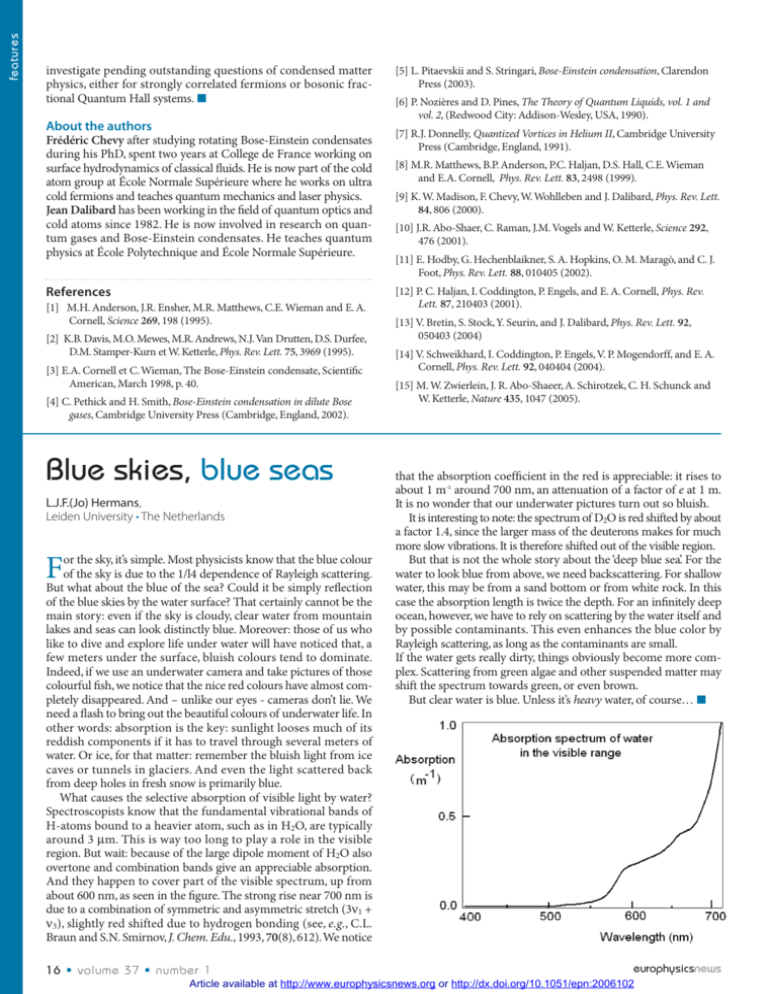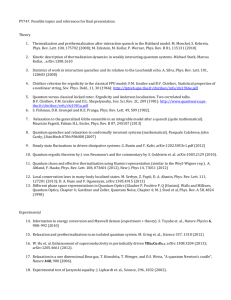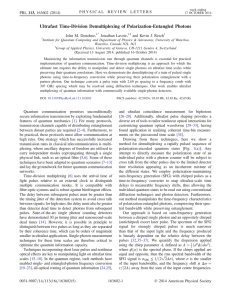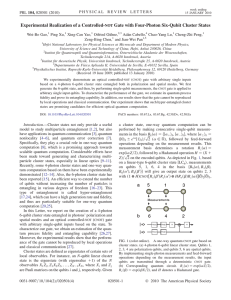Blue skies, blue seas
advertisement

features investigate pending outstanding questions of condensed matter physics, either for strongly correlated fermions or bosonic fractional Quantum Hall systems. About the authors Frédéric Chevy after studying rotating Bose-Einstein condensates during his PhD, spent two years at College de France working on surface hydrodynamics of classical fluids. He is now part of the cold atom group at École Normale Supérieure where he works on ultra cold fermions and teaches quantum mechanics and laser physics. Jean Dalibard has been working in the field of quantum optics and cold atoms since 1982. He is now involved in research on quantum gases and Bose-Einstein condensates. He teaches quantum physics at École Polytechnique and École Normale Supérieure. References [1] M.H. Anderson, J.R. Ensher, M.R. Matthews, C.E. Wieman and E. A. Cornell, Science 269, 198 (1995). [2] K.B. Davis, M.O. Mewes, M.R. Andrews, N.J.Van Drutten, D.S. Durfee, D.M. Stamper-Kurn et W. Ketterle, Phys. Rev. Lett. 75, 3969 (1995). [3] E.A. Cornell et C. Wieman, The Bose-Einstein condensate, Scientific American, March 1998, p. 40. [4] C. Pethick and H. Smith, Bose-Einstein condensation in dilute Bose gases, Cambridge University Press (Cambridge, England, 2002). Blue skies, blue seas L.J.F.(Jo) Hermans, Leiden University • The Netherlands or the sky, it’s simple. Most physicists know that the blue colour of the sky is due to the 1/l4 dependence of Rayleigh scattering. But what about the blue of the sea? Could it be simply reflection of the blue skies by the water surface? That certainly cannot be the main story: even if the sky is cloudy, clear water from mountain lakes and seas can look distinctly blue. Moreover: those of us who like to dive and explore life under water will have noticed that, a few meters under the surface, bluish colours tend to dominate. Indeed, if we use an underwater camera and take pictures of those colourful fish, we notice that the nice red colours have almost completely disappeared. And – unlike our eyes - cameras don’t lie. We need a flash to bring out the beautiful colours of underwater life. In other words: absorption is the key: sunlight looses much of its reddish components if it has to travel through several meters of water. Or ice, for that matter: remember the bluish light from ice caves or tunnels in glaciers. And even the light scattered back from deep holes in fresh snow is primarily blue. What causes the selective absorption of visible light by water? Spectroscopists know that the fundamental vibrational bands of H-atoms bound to a heavier atom, such as in H2O, are typically around 3 µm. This is way too long to play a role in the visible region. But wait: because of the large dipole moment of H2O also overtone and combination bands give an appreciable absorption. And they happen to cover part of the visible spectrum, up from about 600 nm, as seen in the figure. The strong rise near 700 nm is due to a combination of symmetric and asymmetric stretch (3ν1 + ν3), slightly red shifted due to hydrogen bonding (see, e.g., C.L. Braun and S.N. Smirnov, J. Chem. Edu., 1993, 70(8), 612).We notice F 16 • volume 37 • number 1 [5] L. Pitaevskii and S. Stringari, Bose-Einstein condensation, Clarendon Press (2003). [6] P. Nozières and D. Pines, The Theory of Quantum Liquids, vol. 1 and vol. 2, (Redwood City: Addison-Wesley, USA, 1990). [7] R.J. Donnelly, Quantized Vortices in Helium II, Cambridge University Press (Cambridge, England, 1991). [8] M.R. Matthews, B.P. Anderson, P.C. Haljan, D.S. Hall, C.E. Wieman and E.A. Cornell, Phys. Rev. Lett. 83, 2498 (1999). [9] K. W. Madison, F. Chevy, W. Wohlleben and J. Dalibard, Phys. Rev. Lett. 84, 806 (2000). [10] J.R. Abo-Shaer, C. Raman, J.M. Vogels and W. Ketterle, Science 292, 476 (2001). [11] E. Hodby, G. Hechenblaikner, S. A. Hopkins, O. M. Maragò, and C. J. Foot, Phys. Rev. Lett. 88, 010405 (2002). [12] P. C. Haljan, I. Coddington, P. Engels, and E. A. Cornell, Phys. Rev. Lett. 87, 210403 (2001). [13] V. Bretin, S. Stock, Y. Seurin, and J. Dalibard, Phys. Rev. Lett. 92, 050403 (2004) [14] V. Schweikhard, I. Coddington, P. Engels, V. P. Mogendorff, and E. A. Cornell, Phys. Rev. Lett. 92, 040404 (2004). [15] M. W. Zwierlein, J. R. Abo-Shaeer, A. Schirotzek, C. H. Schunck and W. Ketterle, Nature 435, 1047 (2005). that the absorption coefficient in the red is appreciable: it rises to about 1 m-1 around 700 nm, an attenuation of a factor of e at 1 m. It is no wonder that our underwater pictures turn out so bluish. It is interesting to note: the spectrum of D2O is red shifted by about a factor 1.4, since the larger mass of the deuterons makes for much more slow vibrations. It is therefore shifted out of the visible region. But that is not the whole story about the ‘deep blue sea’. For the water to look blue from above, we need backscattering. For shallow water, this may be from a sand bottom or from white rock. In this case the absorption length is twice the depth. For an infinitely deep ocean, however, we have to rely on scattering by the water itself and by possible contaminants. This even enhances the blue color by Rayleigh scattering, as long as the contaminants are small. If the water gets really dirty, things obviously become more complex. Scattering from green algae and other suspended matter may shift the spectrum towards green, or even brown. But clear water is blue. Unless it’s heavy water, of course… europhysicsnews Article available at http://www.europhysicsnews.org or http://dx.doi.org/10.1051/epn:2006102
![[1]. In a second set of experiments we made use of an](http://s3.studylib.net/store/data/006848904_1-d28947f67e826ba748445eb0aaff5818-300x300.png)










